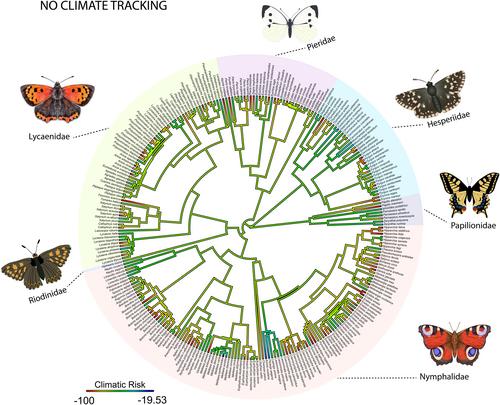Disentangling the Influence of Phylogeny and Traits on Climatic Risk of European Butterflies
Abstract
Aim
The relative importance of traits and phylogeny to predict species extinction risk is unclear and it depends on which traits are measured and their phylogenetic conservatism. Here, we evaluate the power of functional traits, ecological characteristics, such as range size and specialization, and phylogeny to predict climatic risks in European butterflies.
Location
Europe.
Time Period
Distribution data from 1981 to 2002 was used to project range shifts up to 2080.
Major Taxa Studied
In total, 268 European butterfly species (Rhopalocera).
Methods
We extracted information on climatic risk for each species from the literature. Two hypothetical conditions were assumed: full climate tracking and no climate tracking. We used variation partitioning to quantify and disentangle the effects of phylogeny, four traits (wingspan, voltinism, overwintering and egg volume) and two ecological characteristics (range size and specialization) on climatic risk. We used Random Forest as an imputation method to predict climatic risk values for additional European butterfly species that have not been previously modelled.
Results
Range size and degree of specialization strongly predicted climatic risk of European butterflies, but only for no climate tracking scenarios. Overall, more generalist species have larger ranges and are less vulnerable to climate change. Furthermore, we found that phylogenetic information adds strong power to explain climatic risk, especially, but not exclusively for scenarios that assume full climate tracking.
Main Conclusions
Considering current scenarios of habitat fragmentation in Europe, it is likely that species with smaller ranges and high degree of specialization will be unable to track their climates and thus be more at risk. However, our results imply that assisting dispersal and colonization might allow small ranged species to cope with climate change. Our analysis also indicate that phylogeny can be used as a proxy of unmeasured traits to predict climatic risk under certain circumstances.


 求助内容:
求助内容: 应助结果提醒方式:
应助结果提醒方式:


